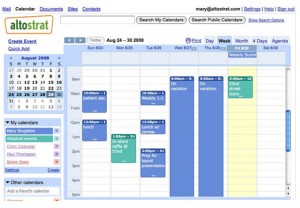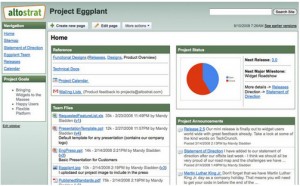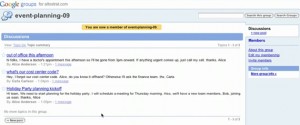Google Docs
 Google Docs is a web-based suite for word processing, presentation building (similar to PowerPoint), spreadsheets, and web forms. All the work is done in a web browser, and all the data is saved in the cloud.
Google Docs is a web-based suite for word processing, presentation building (similar to PowerPoint), spreadsheets, and web forms. All the work is done in a web browser, and all the data is saved in the cloud.
The software can be a bit quirky at times, which may frustrate users of more stable products like Microsoft Office, but the payoff in online storage, shareability, and collaboration options may be worth the adjustment for many small businesses.
Because the data is online, streamlined document sharing and collaboration are big perks with Google Docs. Any file you’re working on can be shared with individual team members, or the entire group within the apps system. You can also set permissions for specific users to view and edit documents. And, multiple users can simultaneously view and edit documents, which can be useful for real-time collaborative projects or presentations during conference calls. You can also grant permission for those outside your office network to view and edit documents, which can be especially useful for sharing information and presentations with clients or colleagues.
As you create and share documents, your Google Docs dashboard may start to get a little messy. Be sure to create folders to keep your work organized just as you would on your desktop. You can also share entire folders if you need to collaborate on multiple documents related to the same project.
Google Calendar
 Google Calendar provides an efficient and intuitive way to keep appointments and events synced across your entire business. With calendar sharing and permissions (similar to those in Docs), you can add other employees’ calendars to your own, and vice versa, in order to see and manage the big picture of your team’s time.
Google Calendar provides an efficient and intuitive way to keep appointments and events synced across your entire business. With calendar sharing and permissions (similar to those in Docs), you can add other employees’ calendars to your own, and vice versa, in order to see and manage the big picture of your team’s time.
For example, if an executive has an assistant, their calendars may be shared so that the assistant could manage his boss’s appointments remotely from his own account. It’s also a smart tool for coordinating meetings, calls, and shift staffing for multiple employees to avoid scheduling conflicts. Sharing multiple calendars with one “master calendar” creates a color-coded scheduling table for the coordinator that updates automatically when users make changes or additions.
The Calendar app can also be used to create events through Gmail. By adding your employees’ e-mail addresses to an event, they will receive an invitation to respond. Responding ‘yes’ automatically adds a shared event to your calendar that each invitee can view and add notes to. It’s a smart way to coordinate meetings and keep everyone in the loop.
Google Sites
Google Sites is a drag-and-drop web development tool that you can use within your business’s apps to create online information hubs for employees. The websites you create exist within your Google Apps domain, can be public or private, and permissions for employees to add, change, and contribute information can be set from the main account.
Beyond simply being a WYSIWYG web editor, Sites makes it easy to integrate data from other Google Apps into dynamic pages that team members can use to collaborate on projects. Integrating spreadsheets or data charts from Docs, a deadline schedule from Calendar, and team-specific messages from Gmail could essentially create a one-stop project dashboard full of dynamically updating information.
Sites here can be purely functional or informational, or with the aid of some built-in templates or a good designer, a full-fledged dynamic public website for your business that team members have easy access to.
Google Groups
Google Groups have long been public forums where users across the web gather to discuss specific interests or get technical support. Groups for business brings that same functionality into your private internal network.
E-mail can sometimes be cumbersome when coordinating a team. When you need a central space to collect ideas and share documents (but you’re not interested in building a web page in Sites), Groups offers a solution.
Employees can create discussion groups on their own and subscribe, either by e-mail or via a Groups dashboard, which lists new posts like a news reader.
Rather than e-mails going out to individual inboxes, a group thread remains visible to all of your subscribed team members, and users can go back to it for reference, to add more information, and even share docs and calendars.
Using Groups for business discussions and project management creates a communal and searchable database of information that employees can go back to whenever needed.

